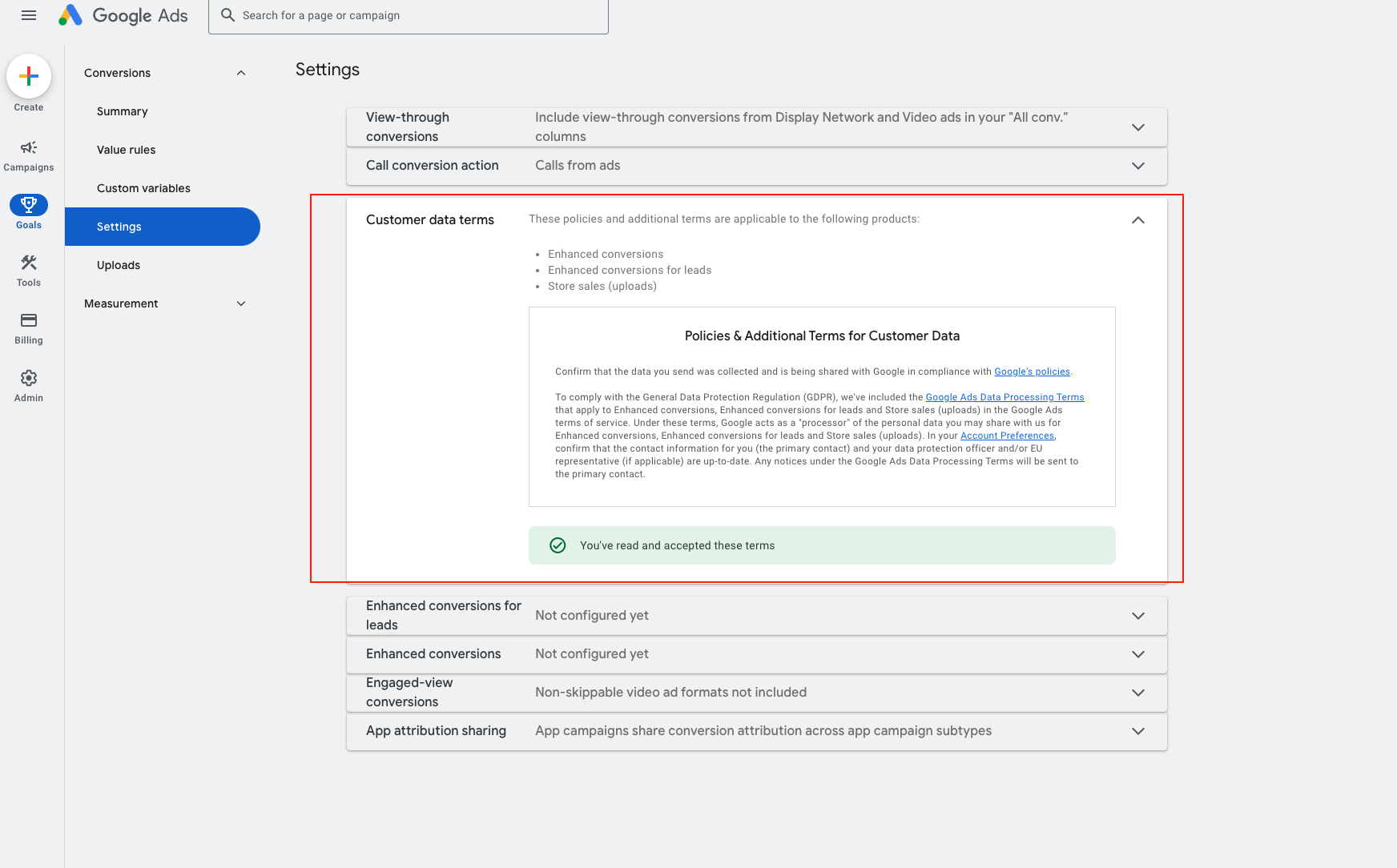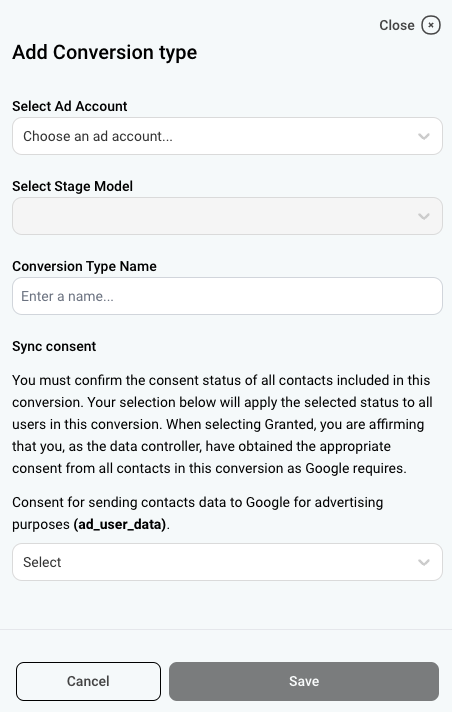Google Ads Offline Conversion
- Why use Google Offline Conversion?
- What permissions are required for us to send data to Google Ads?
- Do you have cross-account conversion tracking enabled?
- How to add a sync?
- What data does Dreamdata send to Google Ads?
- How External Attribution Credit and Value are calculated?
- Can conversions be adjusted after being sent to Google Ads?
- How to view conversion actions Dreamdata Created on your Google Ads Platform?
- How to view conversion metrics related to Google Offline Conversions on Google Ads Platform?
- How can I compare the conversions and conversion value between Dreamdata and Google Ads?
Why use Google Offline Conversion?
Using Google Ads offline conversion tracking can help you get a better understanding of the impact of your online advertising on offline conversions, which can lead to more effective campaigns and better ROI.
- Better ROI measurement: by combining Google Ads Offline Conversion and automated bid strategies, Google can help you optimize campaigns to generate more conversions at a lower cost. To learn more details, read Use automated bidding with offline conversion imports section here
- Improved campaign targeting: if you find that a particular ad or keyword is driving a lot of offline conversions, you can focus on refining the targeting and messaging with that knowledge for future campaigns.
What permissions are required for us to send data to Google Ads?
- To successfully send data to Google Ads through Dreamdata Google Offline Conversion, the person connecting with it needs to have one of the following permissions for your ad account:
- Admin
- Standard
- You also need to make sure to accept Google Ads customer data terms : Go to your Google Ads account -> Goals -> Conversions -> Settings -> Accept Customer Data Terms

Do you have cross-account conversion tracking enabled?
If you use a MCC account to manage conversions across all of your Google ads accounts, you only need to add the offline conversion sync to your MCC accounts. Read more about cross-account conversion tracking.
How to add a sync?
- Go to Dreamdata App Data Platform -> Destinations -> Google Ads Offline Conversions
- Connect your Google Ads account
- Choose an account you want to send conversions to
- Choose a stage that you want to measure as an offline conversion
- You must also confirm the consent status of all contacts included in this conversion by making a selection in the dropdown for ad_user_data (sending user data to Google for advertising purposes). You can read more about Google's consent policy here.
- Click Save, and you are all set

Note:
- It takes up to 24 hours after sync creation for Dreamdata to send data to Google.
- It takes Google up to 24 hours after getting the data from Dreamdata before you will see the offline conversions in Google Ads Platform.
- Dreamdata will sync your conversion data once a day at around 3 AM UTC timezone
What data does Dreamdata send to Google Ads?
Dreamdata only sends recent 90 days stage reached info of a contact to Google Ads, starting from the sync creation date.
After adding the sync, Dreamdata will send the following data to Google Ads:
- GCLID
- GBRAID if GCLID can not be found
- WBRAID if GCLID and GBRAID can not be found
- Email Address (hashed)
- Conversion Time
- Conversion Value
- Currency
- External Attribution Model
- External Attribution Credit
How External Attribution Credit and Value are calculated?
Dreamdata use Linear attribution model for Google Ads Offline Conversion data. The value of a conversion is linearly split among all the Google Ad clicks.
Example:
Assume the following customer journey:

For MQL conversion action, we send the following conversions:
GCLID | ConversionTime | Conversion Value | Currency | External Attribution Credit | External Attribution Model |
GCLID2 | 2022-03-01 | 30 | USD | 0.5 | Linear |
GCLID3 | 2022-03-01 | 30 | USD | 0.5 | Linear |
For SQL conversion action, we send the following conversions
GCLID | Conversion Time | Conversion Value | Currency | External Attribution Credit | External Attribution Model |
GCLID2 | 2022-03-05 | 100 | USD | 0.333 | Linear |
GCLID3 | 2022-03-05 | 100 | USD | 0.333 | Linear |
GCLID4 | 2022-03-05 | 100 | USD | 0.333 | Linear |
Note:
- The conversion window for an ad click is set to 90 days (That's why GCLID1 is not sent to Google Ads in the above examples).
- Only data with recent 90 days Conversion Time can be sent to Google Ads.
- Only GCLID generated in recent 90 days can be sent as google offline conversions.
Can conversions be adjusted after being sent to Google Ads?
Google Ads only allow adjustment for conversion value and currency up to 55 days from when the conversion was first sent.
There are two scenarios Dreamdata will adjust the conversions after being sent:
- When the value of a conversion is changed.
Assuming you define one MQL is worth $200. A few days later, you decided one MQL is worth $400. We will adjust the conversion value of all relative conversions accordingly, if the conversions were sent in recent 55 days. - A new GCLID is identified for a conversion.
Assume we have sent conversions of a MQL to Google Ads. A few days later, you added a new contact in your CRM system that is associated with that MQL. Dreamdata found out this contact clicked your Google Ads campaign, and it happen within 90 days conversion window. Dreamdata will re-distribute the conversion value across all google ad clicks, send this new conversion to Google Ads and adjust the conversions that have been sent to Google in recent 55 days.
How to view conversion actions Dreamdata Created on your Google Ads Platform?
- Go to Google Ads Platform -> Goals -> Conversions -> Summary -> Change timerange to All time
- If your Google Ads account received offline conversions from Dreamdata, you will see an active green sign in the status column

How to view conversion metrics related to Google Offline Conversions on Google Ads Platform?
- Go to Google Ads Platform Campaigns view
- Select Segment -> Conversions -> Conversion action
- Add following columns:
- All conv. (by conv. time)
- All conv. value (by conv. time)
All conv. value (by conv. time) should be the sum of External Attribution Value
How can I compare the conversions and conversion value between Dreamdata and Google Ads?
You shouldn't expect exact match between All conv. (by conv. time) metric in Google Ads and influenced deals metric in Dreamdata, due to multiple restrictions Google Ads set when uploading the offline conversion data, for example:
- 55 days adjustment window
- 90 days conversion windows
- recent 90 days conversions
- recent 90 days clicks
- GCLID generated outside the Google Network is not accepted by the conversion upload.
However, those conversion data can definitely send a strong signal to your Google Ad campaigns for ROI improvement.
